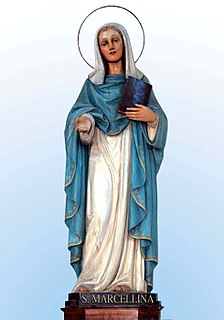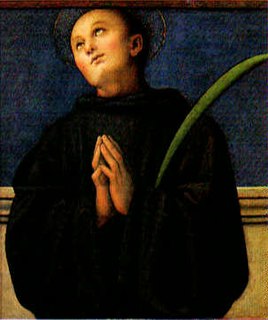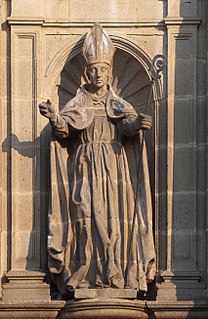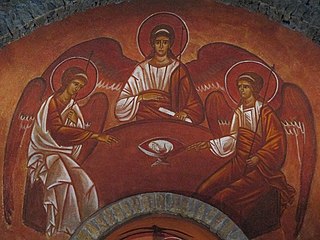Saint Flavia is a saint of the Roman Catholic Church. She was martyred at Messina along with her brother, the Benedictine monk Saint Placidus, their brothers Eutychius and Victorinus, Donatus, Firmatus the deacon, Faustus, and thirty other monks. They were killed by pirates. Their feast day is October 15. Saint Flavia was from Paleramo Sicily. In Paleramo there is a part called Santa Flavia after her. [1]

The Carthusians, also known as the Order of Carthusians, are a Latin enclosed religious order of the Catholic Church. The order was founded by Bruno of Cologne in 1084 and includes both monks and nuns. The order has its own rule, called the Statutes, and their life combines both eremitical and cenobitic monasticism. The motto of the Carthusians is Stat crux dum volvitur orbis, Latin for "The Cross is steady while the world turns." The Carthusians retain a unique form of liturgy known as the Carthusian Rite.

James the Great, also known as James, son of Zebedee, Saint James the Great, Saint James the Greater, or Saint Jacob, was one of the Twelve Apostles of Jesus, the first apostle to be martyred according to the New Testament. Saint James is the patron saint of Spain and, according to tradition, his remains are held in Santiago de Compostela in Galicia.

A friar is a member of one of the mendicant orders founded in the twelfth or thirteenth century; the term distinguishes the mendicants' itinerant apostolic character, exercised broadly under the jurisdiction of a superior general, from the older monastic orders' allegiance to a single monastery formalized by their vow of stability. A friar may be in holy orders or a brother. The most significant orders of friars are the Dominicans, Franciscans, Augustinians, and Carmelites.

The Bridgettines, or Birgittines, formally known as the Order of the Most Holy Savior, is a monastic religious order of the Catholic Church founded by Saint Birgitta or Bridget of Sweden in 1344, and approved by Pope Urban V in 1370. They follow the Rule of Saint Augustine. There are today several different branches of Bridgettines.

Saint Hermenegild or Ermengild, was the son of king Liuvigild of the Visigothic Kingdom in the Iberian Peninsula and southern France. He fell out with his father in 579, then revolted the following year. During his rebellion, he converted from Arianism to Chalcedonian Christianity. Hermenegild was defeated in 584 and exiled. His death was later celebrated as a martyrdom due to the influence of Pope Gregory I's Dialogues, in which he portrayed Hermenegild as a "Catholic martyr rebelling against the tyranny of an Arian father."

The Order of Saint Jerome or Hieronymites is a Catholic cloistered religious order and a common name for several congregations of hermit monks living according to the Rule of Saint Augustine, though the role principle of their lives is the 5th-century hermit and biblical scholar Jerome.
Itta of Metz, O.S.B. was the wife of Pepin of Landen, Mayor of the Palace of the Kingdom of Austrasia. After his death, she founded the Abbey of Nivelles, where she became a Colombanian nun along with her daughter, Gertrude of Nivelles. Both are honored as saints by the Catholic Church.

Marcellina was born in Trier, Gaul the daughter of the Praetorian prefect of Gaul, and was the elder sister of Ambrose of Milan and Satyrus of Milan. Marcellina devoted her life as a consecrated virgin to the practice of prayer and asceticism. Her feast is on 17 July.

Saint Placidus (Placitus), along with Saints Eutychius (Euticius), Victorinus and their sister Flavia, Donatus, Firmatus the deacon, Faustus, and thirty others, have been venerated as Christian martyrs. They were said to be martyred either by pirates at Messina or under the Emperor Diocletian.
Trasilla and Emiliana were aunts of Gregory the Great, and venerated as virgin saints of the sixth century. They appear in the Roman Martyrology, the former on 24 December, the latter on 5 January.

Flavia Domitilla the Younger or Flavia Domitilla Minor was the only daughter of the Roman Emperor Vespasian.
Flavia Domitilla was a Roman noblewoman of the 1st century. She was a granddaughter of Emperor Vespasian and a niece of Emperors Titus and Domitian. She married her cousin, the consul Titus Flavius Clemens, a grand-nephew of Vespasian through his father Titus Flavius Sabinus.

Burgundofara, also Saint Fara or Fare, was the founder and first Abbess of the Abbey of Faremoutiers. Her family is knowns as the Faronids, named after her brother Saint Faro. Her name may mean: 'She who moves the Burgundians'.

Marina, distinguished as Marina the Monk and also known as Marinos, Pelagia and Mary of Alexandria, was a Christian saint from part of Asian Byzantium, variously said to be Lebanon. Details of the saint's life vary.
Waldalenus, or Wandalenus, dux in the region between the Alps and the Jura, in the Frankish Kingdom of Burgundy, was a Frankish magnate who served as mayor of the Austrasian palace at Metz from 581, during the minority of Childebert II.

Saint Rudesind was a Galician bishop and abbot. He was also a regional administrator and military leader under his kinsmen, the Kings of León.
Sant'Elia, Elia being the Italian name for the prophet Elijah, may refer to:
A religious brother is a member of a Christian religious institute or religious order who commits himself to following Christ in consecrated life of the Church, usually by the vows of poverty, chastity and obedience. He is a layman, in the sense of not being ordained as a deacon or priest, and usually lives in a religious community and works in a ministry appropriate to his capabilities. A brother might practice any secular occupation. The term "brother" is used as he is expected to be as a brother to others. Brothers are members of a variety of religious communities, which may be contemplative, monastic, or apostolic in character. Some religious institutes are composed only of brothers; others are so-called "mixed" communities that are made up of brothers and clerics.
Ingunde, Ingund, Ingundis or Ingunda, was the eldest child of Sigebert I, king of Austrasia, and his wife Brunhilda, daughter of King Athanagild of the Visigoths. She married Hermenegild and became the first Catholic queen of the Visigoths.

The Monastic Family of Bethlehem, of the Assumption of the Virgin and of Saint Bruno is a Roman Catholic institute of consecrated life that practices Carthusian spirituality and was founded through the inspiration of a small group of French pilgrims on November 1, 1950, at St. Peter's Square, in the Vatican City, following the promulgation of the dogma of the Assumption of the Blessed Virgin Mary into Heaven. The Monastic Sisters were founded in France, soon after, and the Monastic Brothers in 1976.